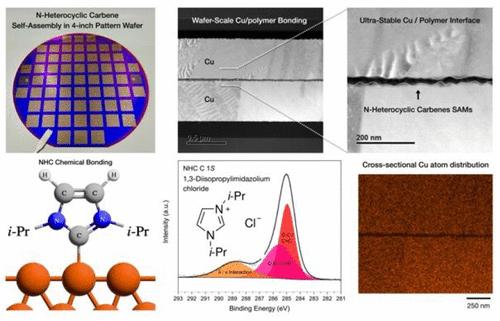当前位置:
X-MOL 学术
›
ACS Appl. Mater. Interfaces
›
论文详情
Our official English website, www.x-mol.net, welcomes your feedback! (Note: you will need to create a separate account there.)
Ultrastable 3D Heterogeneous Integration via N-Heterocyclic Carbene Self-Assembled Nanolayers
ACS Applied Materials & Interfaces ( IF 8.3 ) Pub Date : 2024-06-27 , DOI: 10.1021/acsami.4c04665 Jinhyoung Lee 1, 2 , Gunhoo Woo 3, 4 , Gyuyoung Lee 1 , Jongyeong Jeon 1 , Seunghwan Lee 1 , Ziyang Wang 1 , Hyelim Shin 5 , Gil-Woo Lee 1, 6 , Yeon-Ji Kim 1, 6 , Do-Hyun Lee 1, 6 , Min-Jae Kim 3, 4 , Eungchul Kim 7 , Hyunho Seok 3, 4 , Jinill Cho 1 , Boseok Kang 3, 4, 8 , You-Shin No 6 , Won-Jun Jang 2, 9 , Taesung Kim 1, 3, 4, 5, 8
ACS Applied Materials & Interfaces ( IF 8.3 ) Pub Date : 2024-06-27 , DOI: 10.1021/acsami.4c04665 Jinhyoung Lee 1, 2 , Gunhoo Woo 3, 4 , Gyuyoung Lee 1 , Jongyeong Jeon 1 , Seunghwan Lee 1 , Ziyang Wang 1 , Hyelim Shin 5 , Gil-Woo Lee 1, 6 , Yeon-Ji Kim 1, 6 , Do-Hyun Lee 1, 6 , Min-Jae Kim 3, 4 , Eungchul Kim 7 , Hyunho Seok 3, 4 , Jinill Cho 1 , Boseok Kang 3, 4, 8 , You-Shin No 6 , Won-Jun Jang 2, 9 , Taesung Kim 1, 3, 4, 5, 8
Affiliation

|
The commercialization of 3D heterogeneous integration through hybrid bonding has accelerated, and accordingly, Cu–polymer bonding has gained significant attention as a means of overcoming the limitations of conventional Cu–SiO2 hybrid bonding, offering high compatibility with other fabrication processes. Polymers offer robust bonding strength and a low dielectric constant, enabling high-speed signal transmission with high reliability, but suffer from low thermomechanical stability. Thermomechanical stability of polymers was not achieved previously because of thermal degradation and unstable anchoring. To overcome these limitations, wafer-scale Cu–polymer bonding via N-heterocyclic carbene (NHC) nanolayers was presented for 3D heterogeneous integration, affording ultrastable packing density, crystallinity, and thermal properties. NHC nanolayers were deposited on copper electrodes via electrochemical deposition, and wafer-scale 3D heterogeneous integration was achieved by adhesive bonding at 170 °C for 1 min. Ultrastable conductivity and thermomechanical properties were observed by the spatial mapping of conductivity, work function, and force–distance curves. With regard to the characterization of NHC nanolayers, low-temperature bonding, robust corrosion inhibition, enhanced electrical conductivity, back-end-of-line process compatibility, and fabrication process reduction, NHC Cu/polymer bonding provides versatile advances in 3D heterogeneous integration, indicating that NHC Cu/polymer bonding can be utilized as a platform for future 3D vertical chip architectures.
中文翻译:

通过 N-杂环卡宾自组装纳米层实现超稳定 3D 异质集成
通过混合键合实现 3D 异质集成的商业化进程加速,因此,Cu-聚合物键合作为克服传统 Cu-SiO 2 混合键合局限性的一种手段而受到广泛关注,并与其他材料具有高度兼容性。制造工艺。聚合物具有强大的粘合强度和低介电常数,可实现高可靠性的高速信号传输,但热机械稳定性较低。由于热降解和不稳定的锚定,以前未能实现聚合物的热机械稳定性。为了克服这些限制,通过 N-杂环卡宾 (NHC) 纳米层进行晶圆级铜聚合物键合,用于 3D 异质集成,提供超稳定的堆积密度、结晶度和热性能。通过电化学沉积将 NHC 纳米层沉积在铜电极上,并通过在 170 °C 下粘合 1 分钟实现晶圆级 3D 异质集成。通过电导率、功函数和力-距离曲线的空间映射观察超稳定电导率和热机械性能。在 NHC 纳米层的表征、低温键合、强大的腐蚀抑制、增强的导电性、后端工艺兼容性和制造工艺减少方面,NHC Cu/聚合物键合在 3D 异质集成方面提供了多种进步,表明 NHC 铜/聚合物键合可以用作未来 3D 垂直芯片架构的平台。
更新日期:2024-06-30
中文翻译:

通过 N-杂环卡宾自组装纳米层实现超稳定 3D 异质集成
通过混合键合实现 3D 异质集成的商业化进程加速,因此,Cu-聚合物键合作为克服传统 Cu-SiO 2 混合键合局限性的一种手段而受到广泛关注,并与其他材料具有高度兼容性。制造工艺。聚合物具有强大的粘合强度和低介电常数,可实现高可靠性的高速信号传输,但热机械稳定性较低。由于热降解和不稳定的锚定,以前未能实现聚合物的热机械稳定性。为了克服这些限制,通过 N-杂环卡宾 (NHC) 纳米层进行晶圆级铜聚合物键合,用于 3D 异质集成,提供超稳定的堆积密度、结晶度和热性能。通过电化学沉积将 NHC 纳米层沉积在铜电极上,并通过在 170 °C 下粘合 1 分钟实现晶圆级 3D 异质集成。通过电导率、功函数和力-距离曲线的空间映射观察超稳定电导率和热机械性能。在 NHC 纳米层的表征、低温键合、强大的腐蚀抑制、增强的导电性、后端工艺兼容性和制造工艺减少方面,NHC Cu/聚合物键合在 3D 异质集成方面提供了多种进步,表明 NHC 铜/聚合物键合可以用作未来 3D 垂直芯片架构的平台。






































 京公网安备 11010802027423号
京公网安备 11010802027423号